CO5121 Law of Business Organisations: Slater & Gordon Limited Case
VerifiedAdded on 2023/06/12
|11
|2651
|114
Case Study
AI Summary
This case study delves into the legal ramifications surrounding Slater & Gordon Limited, particularly concerning potential class actions and breaches of the Corporations Act 2001. It examines issues such as the company's duty to disclose financial information, potential misleading conduct, and the responsibilities of its directors. The analysis considers whether legal actions against the company are warranted, explores the avenues available to regulatory authorities like ASIC, and investigates the applicability of piercing the corporate veil. The study concludes by assessing the directors' actions, determining whether they acted in the best interests of shareholders, and highlighting the potential consequences under Australian corporate law. Desklib offers a wealth of resources, including solved assignments and past papers, for students studying similar topics.
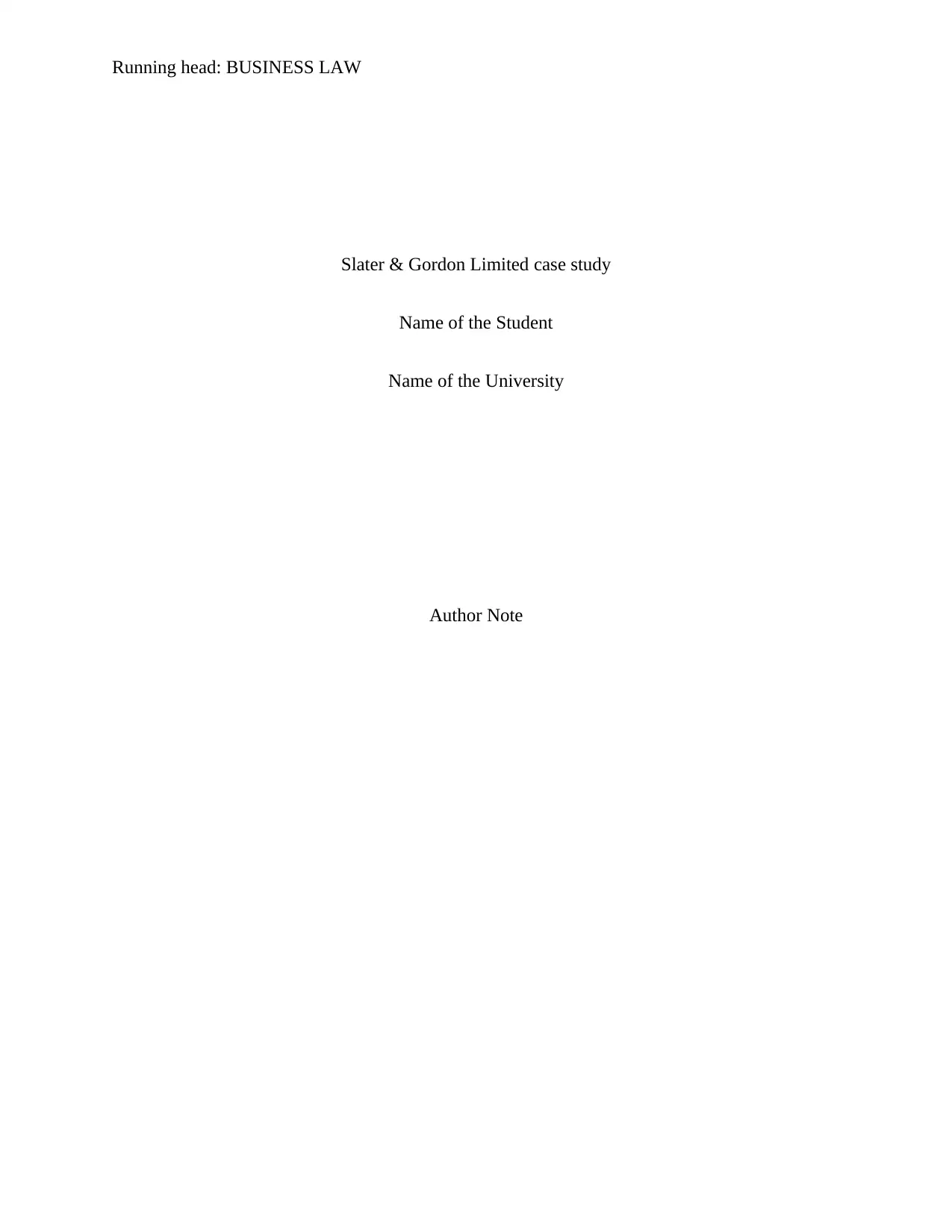
Running head: BUSINESS LAW
Slater & Gordon Limited case study
Name of the Student
Name of the University
Author Note
Slater & Gordon Limited case study
Name of the Student
Name of the University
Author Note
Paraphrase This Document
Need a fresh take? Get an instant paraphrase of this document with our AI Paraphraser
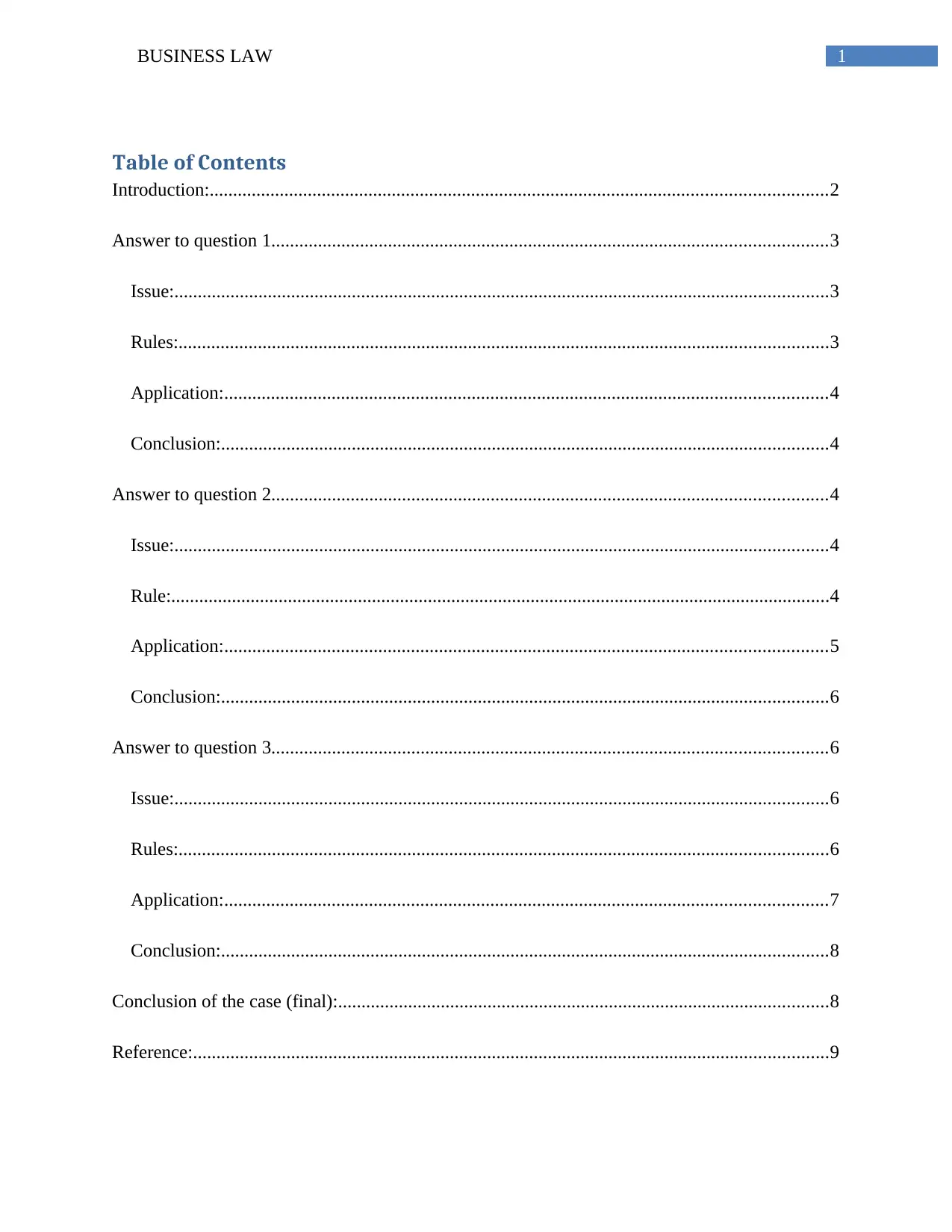
1BUSINESS LAW
Table of Contents
Introduction:....................................................................................................................................2
Answer to question 1.......................................................................................................................3
Issue:............................................................................................................................................3
Rules:...........................................................................................................................................3
Application:.................................................................................................................................4
Conclusion:..................................................................................................................................4
Answer to question 2.......................................................................................................................4
Issue:............................................................................................................................................4
Rule:.............................................................................................................................................4
Application:.................................................................................................................................5
Conclusion:..................................................................................................................................6
Answer to question 3.......................................................................................................................6
Issue:............................................................................................................................................6
Rules:...........................................................................................................................................6
Application:.................................................................................................................................7
Conclusion:..................................................................................................................................8
Conclusion of the case (final):.........................................................................................................8
Reference:........................................................................................................................................9
Table of Contents
Introduction:....................................................................................................................................2
Answer to question 1.......................................................................................................................3
Issue:............................................................................................................................................3
Rules:...........................................................................................................................................3
Application:.................................................................................................................................4
Conclusion:..................................................................................................................................4
Answer to question 2.......................................................................................................................4
Issue:............................................................................................................................................4
Rule:.............................................................................................................................................4
Application:.................................................................................................................................5
Conclusion:..................................................................................................................................6
Answer to question 3.......................................................................................................................6
Issue:............................................................................................................................................6
Rules:...........................................................................................................................................6
Application:.................................................................................................................................7
Conclusion:..................................................................................................................................8
Conclusion of the case (final):.........................................................................................................8
Reference:........................................................................................................................................9
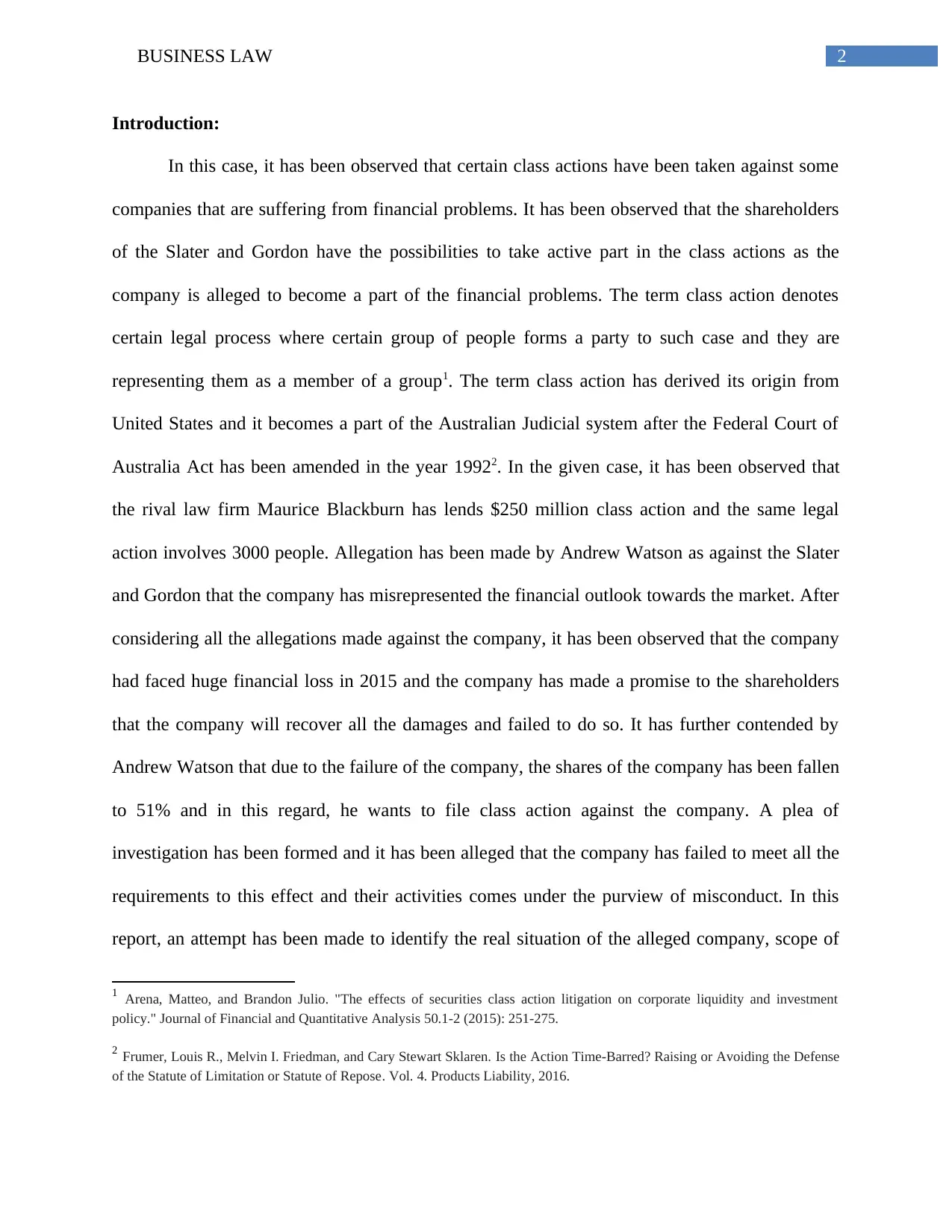
2BUSINESS LAW
Introduction:
In this case, it has been observed that certain class actions have been taken against some
companies that are suffering from financial problems. It has been observed that the shareholders
of the Slater and Gordon have the possibilities to take active part in the class actions as the
company is alleged to become a part of the financial problems. The term class action denotes
certain legal process where certain group of people forms a party to such case and they are
representing them as a member of a group1. The term class action has derived its origin from
United States and it becomes a part of the Australian Judicial system after the Federal Court of
Australia Act has been amended in the year 19922. In the given case, it has been observed that
the rival law firm Maurice Blackburn has lends $250 million class action and the same legal
action involves 3000 people. Allegation has been made by Andrew Watson as against the Slater
and Gordon that the company has misrepresented the financial outlook towards the market. After
considering all the allegations made against the company, it has been observed that the company
had faced huge financial loss in 2015 and the company has made a promise to the shareholders
that the company will recover all the damages and failed to do so. It has further contended by
Andrew Watson that due to the failure of the company, the shares of the company has been fallen
to 51% and in this regard, he wants to file class action against the company. A plea of
investigation has been formed and it has been alleged that the company has failed to meet all the
requirements to this effect and their activities comes under the purview of misconduct. In this
report, an attempt has been made to identify the real situation of the alleged company, scope of
1 Arena, Matteo, and Brandon Julio. "The effects of securities class action litigation on corporate liquidity and investment
policy." Journal of Financial and Quantitative Analysis 50.1-2 (2015): 251-275.
2 Frumer, Louis R., Melvin I. Friedman, and Cary Stewart Sklaren. Is the Action Time-Barred? Raising or Avoiding the Defense
of the Statute of Limitation or Statute of Repose. Vol. 4. Products Liability, 2016.
Introduction:
In this case, it has been observed that certain class actions have been taken against some
companies that are suffering from financial problems. It has been observed that the shareholders
of the Slater and Gordon have the possibilities to take active part in the class actions as the
company is alleged to become a part of the financial problems. The term class action denotes
certain legal process where certain group of people forms a party to such case and they are
representing them as a member of a group1. The term class action has derived its origin from
United States and it becomes a part of the Australian Judicial system after the Federal Court of
Australia Act has been amended in the year 19922. In the given case, it has been observed that
the rival law firm Maurice Blackburn has lends $250 million class action and the same legal
action involves 3000 people. Allegation has been made by Andrew Watson as against the Slater
and Gordon that the company has misrepresented the financial outlook towards the market. After
considering all the allegations made against the company, it has been observed that the company
had faced huge financial loss in 2015 and the company has made a promise to the shareholders
that the company will recover all the damages and failed to do so. It has further contended by
Andrew Watson that due to the failure of the company, the shares of the company has been fallen
to 51% and in this regard, he wants to file class action against the company. A plea of
investigation has been formed and it has been alleged that the company has failed to meet all the
requirements to this effect and their activities comes under the purview of misconduct. In this
report, an attempt has been made to identify the real situation of the alleged company, scope of
1 Arena, Matteo, and Brandon Julio. "The effects of securities class action litigation on corporate liquidity and investment
policy." Journal of Financial and Quantitative Analysis 50.1-2 (2015): 251-275.
2 Frumer, Louis R., Melvin I. Friedman, and Cary Stewart Sklaren. Is the Action Time-Barred? Raising or Avoiding the Defense
of the Statute of Limitation or Statute of Repose. Vol. 4. Products Liability, 2016.
⊘ This is a preview!⊘
Do you want full access?
Subscribe today to unlock all pages.

Trusted by 1+ million students worldwide
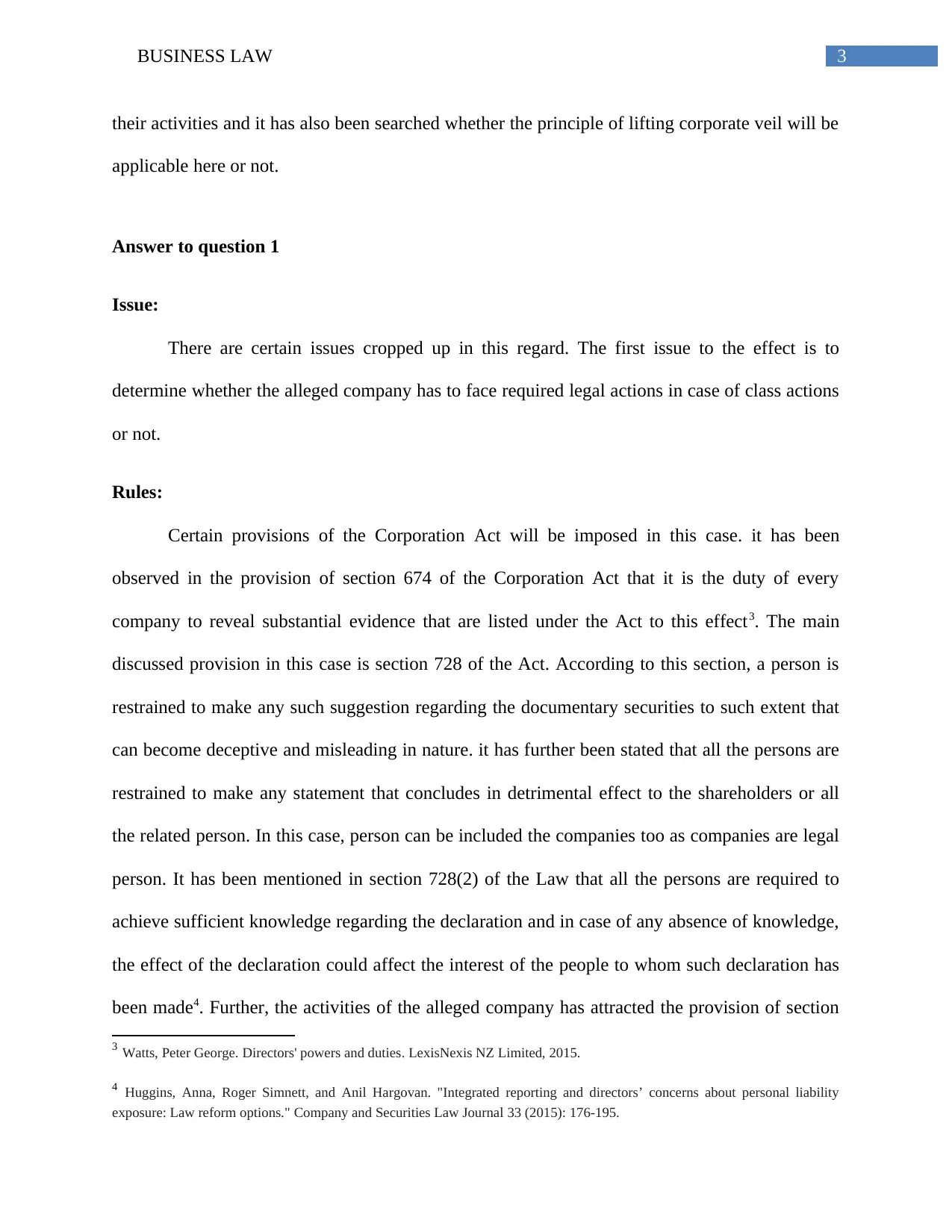
3BUSINESS LAW
their activities and it has also been searched whether the principle of lifting corporate veil will be
applicable here or not.
Answer to question 1
Issue:
There are certain issues cropped up in this regard. The first issue to the effect is to
determine whether the alleged company has to face required legal actions in case of class actions
or not.
Rules:
Certain provisions of the Corporation Act will be imposed in this case. it has been
observed in the provision of section 674 of the Corporation Act that it is the duty of every
company to reveal substantial evidence that are listed under the Act to this effect3. The main
discussed provision in this case is section 728 of the Act. According to this section, a person is
restrained to make any such suggestion regarding the documentary securities to such extent that
can become deceptive and misleading in nature. it has further been stated that all the persons are
restrained to make any statement that concludes in detrimental effect to the shareholders or all
the related person. In this case, person can be included the companies too as companies are legal
person. It has been mentioned in section 728(2) of the Law that all the persons are required to
achieve sufficient knowledge regarding the declaration and in case of any absence of knowledge,
the effect of the declaration could affect the interest of the people to whom such declaration has
been made4. Further, the activities of the alleged company has attracted the provision of section
3 Watts, Peter George. Directors' powers and duties. LexisNexis NZ Limited, 2015.
4 Huggins, Anna, Roger Simnett, and Anil Hargovan. "Integrated reporting and directors’ concerns about personal liability
exposure: Law reform options." Company and Securities Law Journal 33 (2015): 176-195.
their activities and it has also been searched whether the principle of lifting corporate veil will be
applicable here or not.
Answer to question 1
Issue:
There are certain issues cropped up in this regard. The first issue to the effect is to
determine whether the alleged company has to face required legal actions in case of class actions
or not.
Rules:
Certain provisions of the Corporation Act will be imposed in this case. it has been
observed in the provision of section 674 of the Corporation Act that it is the duty of every
company to reveal substantial evidence that are listed under the Act to this effect3. The main
discussed provision in this case is section 728 of the Act. According to this section, a person is
restrained to make any such suggestion regarding the documentary securities to such extent that
can become deceptive and misleading in nature. it has further been stated that all the persons are
restrained to make any statement that concludes in detrimental effect to the shareholders or all
the related person. In this case, person can be included the companies too as companies are legal
person. It has been mentioned in section 728(2) of the Law that all the persons are required to
achieve sufficient knowledge regarding the declaration and in case of any absence of knowledge,
the effect of the declaration could affect the interest of the people to whom such declaration has
been made4. Further, the activities of the alleged company has attracted the provision of section
3 Watts, Peter George. Directors' powers and duties. LexisNexis NZ Limited, 2015.
4 Huggins, Anna, Roger Simnett, and Anil Hargovan. "Integrated reporting and directors’ concerns about personal liability
exposure: Law reform options." Company and Securities Law Journal 33 (2015): 176-195.
Paraphrase This Document
Need a fresh take? Get an instant paraphrase of this document with our AI Paraphraser
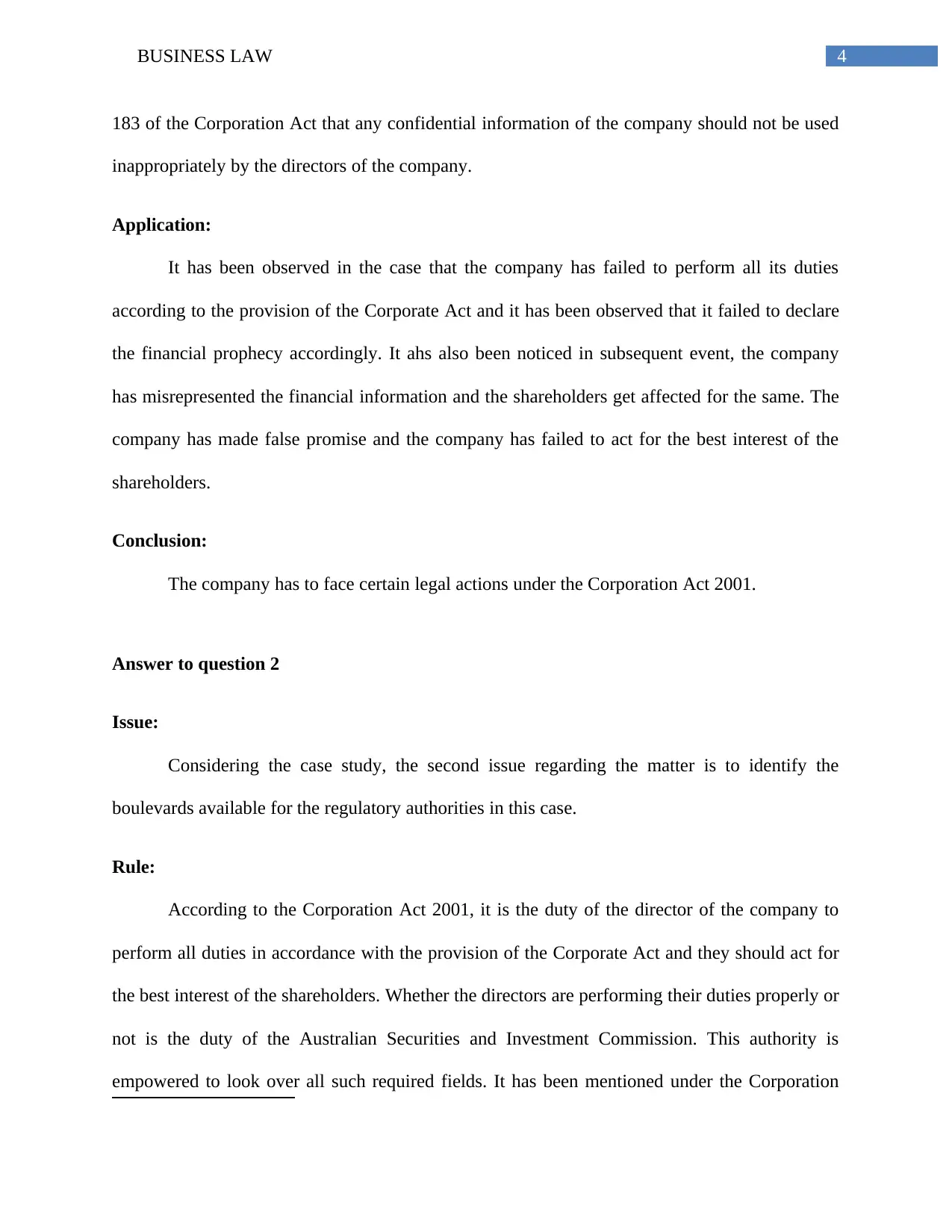
4BUSINESS LAW
183 of the Corporation Act that any confidential information of the company should not be used
inappropriately by the directors of the company.
Application:
It has been observed in the case that the company has failed to perform all its duties
according to the provision of the Corporate Act and it has been observed that it failed to declare
the financial prophecy accordingly. It ahs also been noticed in subsequent event, the company
has misrepresented the financial information and the shareholders get affected for the same. The
company has made false promise and the company has failed to act for the best interest of the
shareholders.
Conclusion:
The company has to face certain legal actions under the Corporation Act 2001.
Answer to question 2
Issue:
Considering the case study, the second issue regarding the matter is to identify the
boulevards available for the regulatory authorities in this case.
Rule:
According to the Corporation Act 2001, it is the duty of the director of the company to
perform all duties in accordance with the provision of the Corporate Act and they should act for
the best interest of the shareholders. Whether the directors are performing their duties properly or
not is the duty of the Australian Securities and Investment Commission. This authority is
empowered to look over all such required fields. It has been mentioned under the Corporation
183 of the Corporation Act that any confidential information of the company should not be used
inappropriately by the directors of the company.
Application:
It has been observed in the case that the company has failed to perform all its duties
according to the provision of the Corporate Act and it has been observed that it failed to declare
the financial prophecy accordingly. It ahs also been noticed in subsequent event, the company
has misrepresented the financial information and the shareholders get affected for the same. The
company has made false promise and the company has failed to act for the best interest of the
shareholders.
Conclusion:
The company has to face certain legal actions under the Corporation Act 2001.
Answer to question 2
Issue:
Considering the case study, the second issue regarding the matter is to identify the
boulevards available for the regulatory authorities in this case.
Rule:
According to the Corporation Act 2001, it is the duty of the director of the company to
perform all duties in accordance with the provision of the Corporate Act and they should act for
the best interest of the shareholders. Whether the directors are performing their duties properly or
not is the duty of the Australian Securities and Investment Commission. This authority is
empowered to look over all such required fields. It has been mentioned under the Corporation
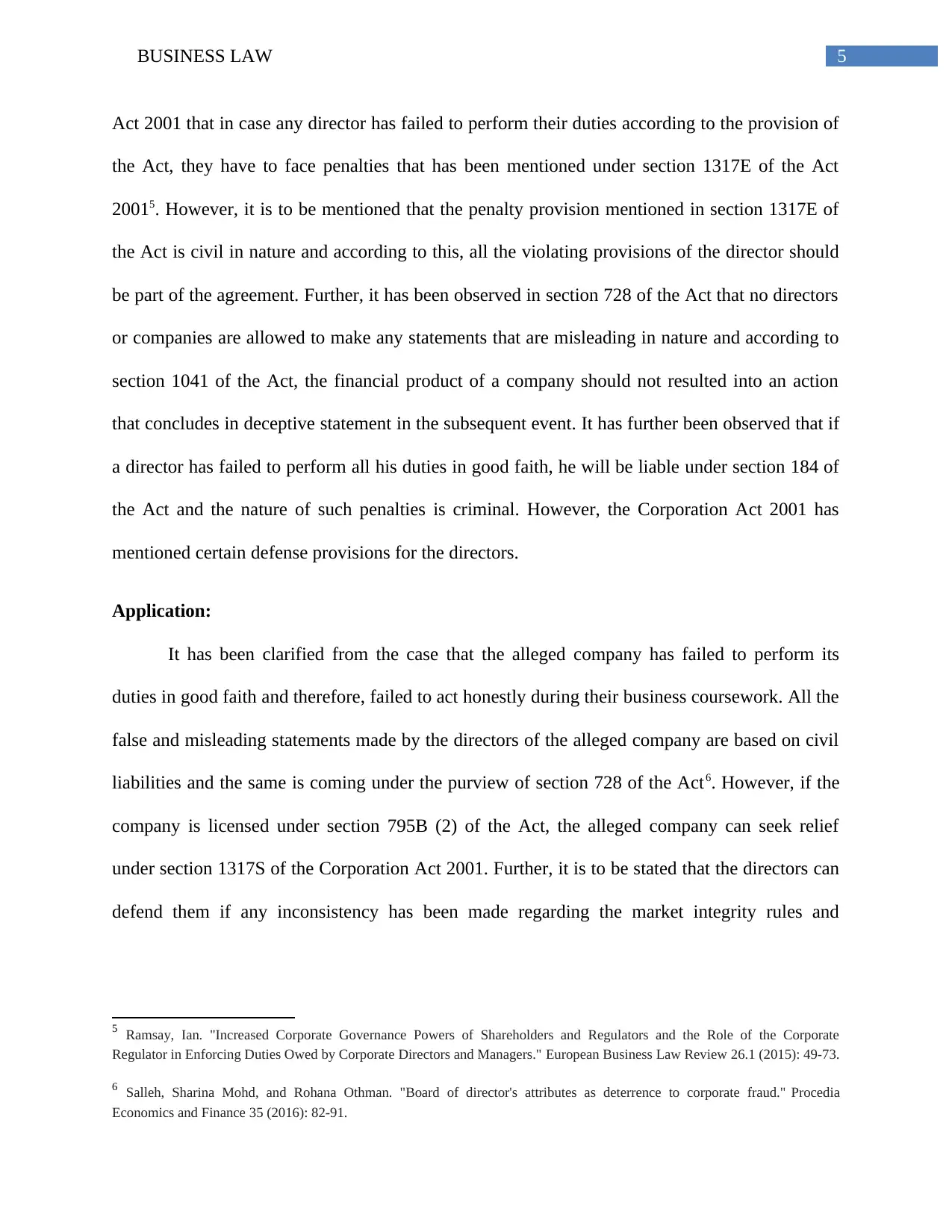
5BUSINESS LAW
Act 2001 that in case any director has failed to perform their duties according to the provision of
the Act, they have to face penalties that has been mentioned under section 1317E of the Act
20015. However, it is to be mentioned that the penalty provision mentioned in section 1317E of
the Act is civil in nature and according to this, all the violating provisions of the director should
be part of the agreement. Further, it has been observed in section 728 of the Act that no directors
or companies are allowed to make any statements that are misleading in nature and according to
section 1041 of the Act, the financial product of a company should not resulted into an action
that concludes in deceptive statement in the subsequent event. It has further been observed that if
a director has failed to perform all his duties in good faith, he will be liable under section 184 of
the Act and the nature of such penalties is criminal. However, the Corporation Act 2001 has
mentioned certain defense provisions for the directors.
Application:
It has been clarified from the case that the alleged company has failed to perform its
duties in good faith and therefore, failed to act honestly during their business coursework. All the
false and misleading statements made by the directors of the alleged company are based on civil
liabilities and the same is coming under the purview of section 728 of the Act6. However, if the
company is licensed under section 795B (2) of the Act, the alleged company can seek relief
under section 1317S of the Corporation Act 2001. Further, it is to be stated that the directors can
defend them if any inconsistency has been made regarding the market integrity rules and
5 Ramsay, Ian. "Increased Corporate Governance Powers of Shareholders and Regulators and the Role of the Corporate
Regulator in Enforcing Duties Owed by Corporate Directors and Managers." European Business Law Review 26.1 (2015): 49-73.
6 Salleh, Sharina Mohd, and Rohana Othman. "Board of director's attributes as deterrence to corporate fraud." Procedia
Economics and Finance 35 (2016): 82-91.
Act 2001 that in case any director has failed to perform their duties according to the provision of
the Act, they have to face penalties that has been mentioned under section 1317E of the Act
20015. However, it is to be mentioned that the penalty provision mentioned in section 1317E of
the Act is civil in nature and according to this, all the violating provisions of the director should
be part of the agreement. Further, it has been observed in section 728 of the Act that no directors
or companies are allowed to make any statements that are misleading in nature and according to
section 1041 of the Act, the financial product of a company should not resulted into an action
that concludes in deceptive statement in the subsequent event. It has further been observed that if
a director has failed to perform all his duties in good faith, he will be liable under section 184 of
the Act and the nature of such penalties is criminal. However, the Corporation Act 2001 has
mentioned certain defense provisions for the directors.
Application:
It has been clarified from the case that the alleged company has failed to perform its
duties in good faith and therefore, failed to act honestly during their business coursework. All the
false and misleading statements made by the directors of the alleged company are based on civil
liabilities and the same is coming under the purview of section 728 of the Act6. However, if the
company is licensed under section 795B (2) of the Act, the alleged company can seek relief
under section 1317S of the Corporation Act 2001. Further, it is to be stated that the directors can
defend them if any inconsistency has been made regarding the market integrity rules and
5 Ramsay, Ian. "Increased Corporate Governance Powers of Shareholders and Regulators and the Role of the Corporate
Regulator in Enforcing Duties Owed by Corporate Directors and Managers." European Business Law Review 26.1 (2015): 49-73.
6 Salleh, Sharina Mohd, and Rohana Othman. "Board of director's attributes as deterrence to corporate fraud." Procedia
Economics and Finance 35 (2016): 82-91.
⊘ This is a preview!⊘
Do you want full access?
Subscribe today to unlock all pages.

Trusted by 1+ million students worldwide
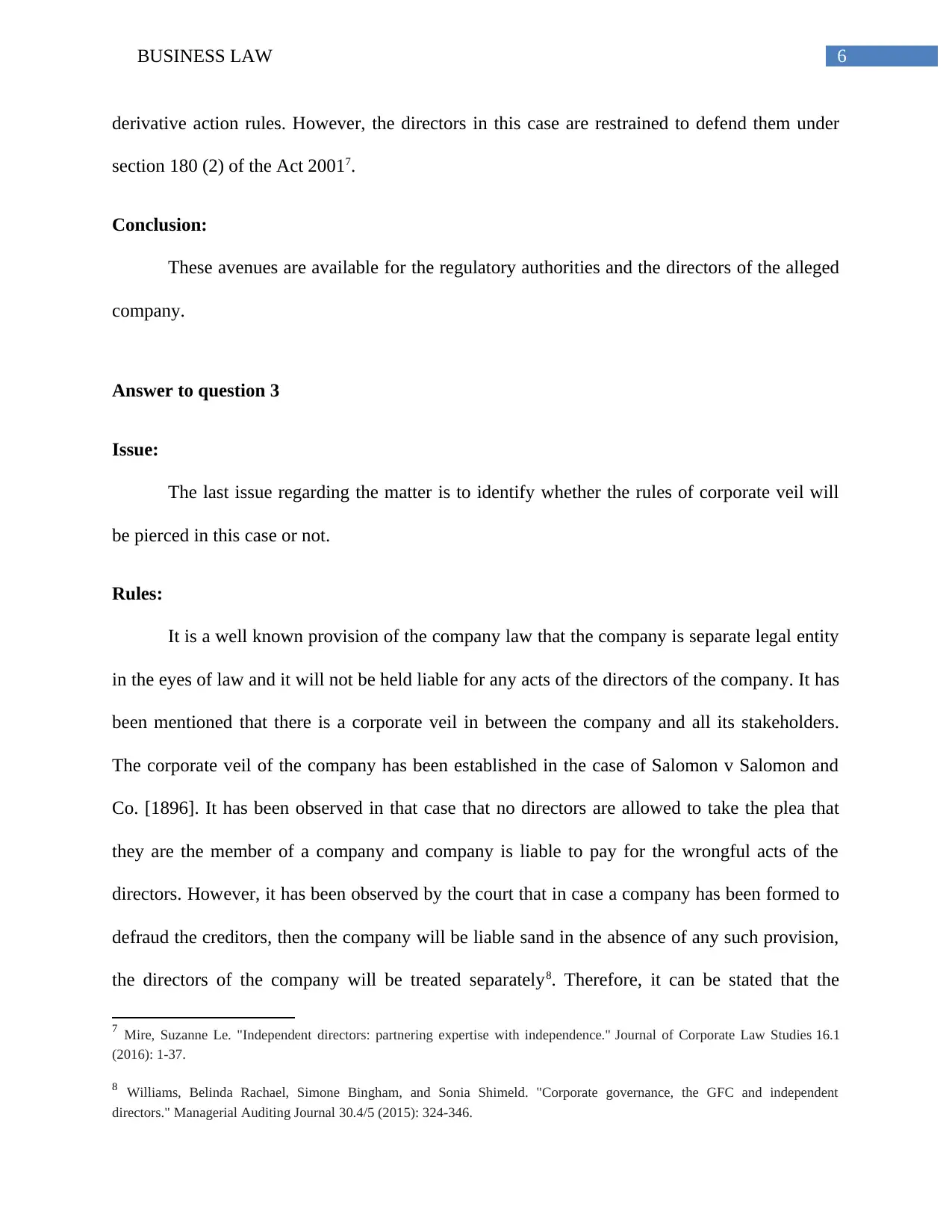
6BUSINESS LAW
derivative action rules. However, the directors in this case are restrained to defend them under
section 180 (2) of the Act 20017.
Conclusion:
These avenues are available for the regulatory authorities and the directors of the alleged
company.
Answer to question 3
Issue:
The last issue regarding the matter is to identify whether the rules of corporate veil will
be pierced in this case or not.
Rules:
It is a well known provision of the company law that the company is separate legal entity
in the eyes of law and it will not be held liable for any acts of the directors of the company. It has
been mentioned that there is a corporate veil in between the company and all its stakeholders.
The corporate veil of the company has been established in the case of Salomon v Salomon and
Co. [1896]. It has been observed in that case that no directors are allowed to take the plea that
they are the member of a company and company is liable to pay for the wrongful acts of the
directors. However, it has been observed by the court that in case a company has been formed to
defraud the creditors, then the company will be liable sand in the absence of any such provision,
the directors of the company will be treated separately8. Therefore, it can be stated that the
7 Mire, Suzanne Le. "Independent directors: partnering expertise with independence." Journal of Corporate Law Studies 16.1
(2016): 1-37.
8 Williams, Belinda Rachael, Simone Bingham, and Sonia Shimeld. "Corporate governance, the GFC and independent
directors." Managerial Auditing Journal 30.4/5 (2015): 324-346.
derivative action rules. However, the directors in this case are restrained to defend them under
section 180 (2) of the Act 20017.
Conclusion:
These avenues are available for the regulatory authorities and the directors of the alleged
company.
Answer to question 3
Issue:
The last issue regarding the matter is to identify whether the rules of corporate veil will
be pierced in this case or not.
Rules:
It is a well known provision of the company law that the company is separate legal entity
in the eyes of law and it will not be held liable for any acts of the directors of the company. It has
been mentioned that there is a corporate veil in between the company and all its stakeholders.
The corporate veil of the company has been established in the case of Salomon v Salomon and
Co. [1896]. It has been observed in that case that no directors are allowed to take the plea that
they are the member of a company and company is liable to pay for the wrongful acts of the
directors. However, it has been observed by the court that in case a company has been formed to
defraud the creditors, then the company will be liable sand in the absence of any such provision,
the directors of the company will be treated separately8. Therefore, it can be stated that the
7 Mire, Suzanne Le. "Independent directors: partnering expertise with independence." Journal of Corporate Law Studies 16.1
(2016): 1-37.
8 Williams, Belinda Rachael, Simone Bingham, and Sonia Shimeld. "Corporate governance, the GFC and independent
directors." Managerial Auditing Journal 30.4/5 (2015): 324-346.
Paraphrase This Document
Need a fresh take? Get an instant paraphrase of this document with our AI Paraphraser
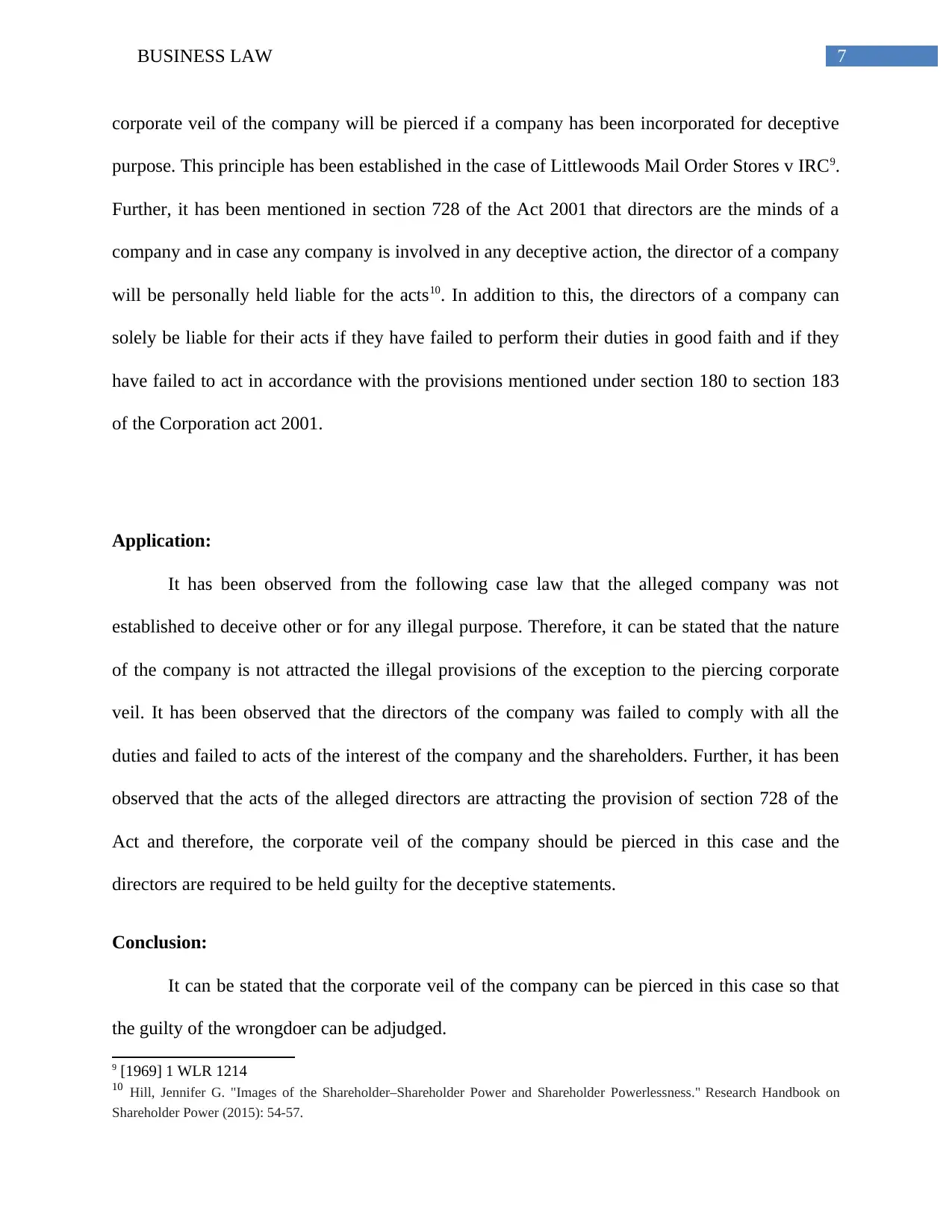
7BUSINESS LAW
corporate veil of the company will be pierced if a company has been incorporated for deceptive
purpose. This principle has been established in the case of Littlewoods Mail Order Stores v IRC9.
Further, it has been mentioned in section 728 of the Act 2001 that directors are the minds of a
company and in case any company is involved in any deceptive action, the director of a company
will be personally held liable for the acts10. In addition to this, the directors of a company can
solely be liable for their acts if they have failed to perform their duties in good faith and if they
have failed to act in accordance with the provisions mentioned under section 180 to section 183
of the Corporation act 2001.
Application:
It has been observed from the following case law that the alleged company was not
established to deceive other or for any illegal purpose. Therefore, it can be stated that the nature
of the company is not attracted the illegal provisions of the exception to the piercing corporate
veil. It has been observed that the directors of the company was failed to comply with all the
duties and failed to acts of the interest of the company and the shareholders. Further, it has been
observed that the acts of the alleged directors are attracting the provision of section 728 of the
Act and therefore, the corporate veil of the company should be pierced in this case and the
directors are required to be held guilty for the deceptive statements.
Conclusion:
It can be stated that the corporate veil of the company can be pierced in this case so that
the guilty of the wrongdoer can be adjudged.
9 [1969] 1 WLR 1214
10 Hill, Jennifer G. "Images of the Shareholder–Shareholder Power and Shareholder Powerlessness." Research Handbook on
Shareholder Power (2015): 54-57.
corporate veil of the company will be pierced if a company has been incorporated for deceptive
purpose. This principle has been established in the case of Littlewoods Mail Order Stores v IRC9.
Further, it has been mentioned in section 728 of the Act 2001 that directors are the minds of a
company and in case any company is involved in any deceptive action, the director of a company
will be personally held liable for the acts10. In addition to this, the directors of a company can
solely be liable for their acts if they have failed to perform their duties in good faith and if they
have failed to act in accordance with the provisions mentioned under section 180 to section 183
of the Corporation act 2001.
Application:
It has been observed from the following case law that the alleged company was not
established to deceive other or for any illegal purpose. Therefore, it can be stated that the nature
of the company is not attracted the illegal provisions of the exception to the piercing corporate
veil. It has been observed that the directors of the company was failed to comply with all the
duties and failed to acts of the interest of the company and the shareholders. Further, it has been
observed that the acts of the alleged directors are attracting the provision of section 728 of the
Act and therefore, the corporate veil of the company should be pierced in this case and the
directors are required to be held guilty for the deceptive statements.
Conclusion:
It can be stated that the corporate veil of the company can be pierced in this case so that
the guilty of the wrongdoer can be adjudged.
9 [1969] 1 WLR 1214
10 Hill, Jennifer G. "Images of the Shareholder–Shareholder Power and Shareholder Powerlessness." Research Handbook on
Shareholder Power (2015): 54-57.
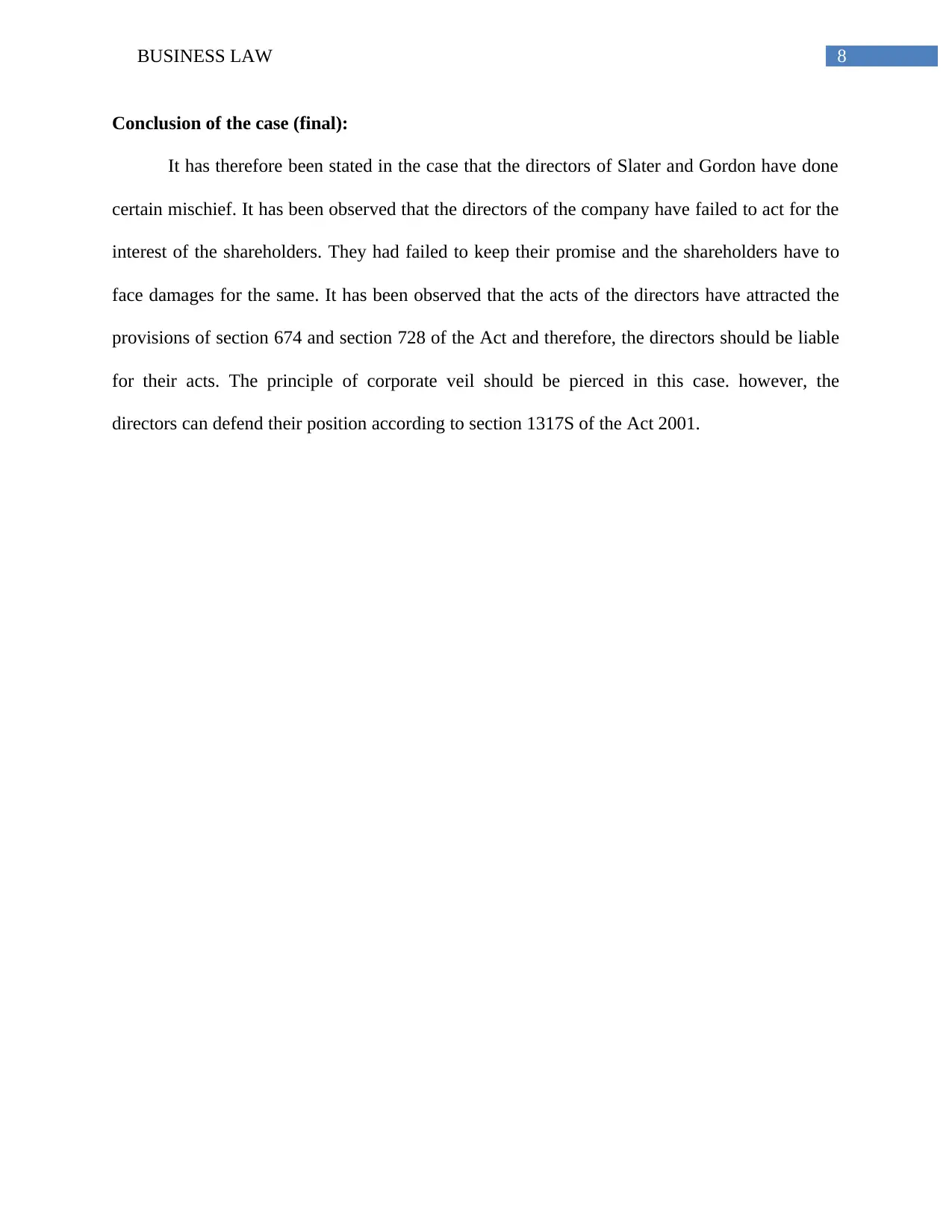
8BUSINESS LAW
Conclusion of the case (final):
It has therefore been stated in the case that the directors of Slater and Gordon have done
certain mischief. It has been observed that the directors of the company have failed to act for the
interest of the shareholders. They had failed to keep their promise and the shareholders have to
face damages for the same. It has been observed that the acts of the directors have attracted the
provisions of section 674 and section 728 of the Act and therefore, the directors should be liable
for their acts. The principle of corporate veil should be pierced in this case. however, the
directors can defend their position according to section 1317S of the Act 2001.
Conclusion of the case (final):
It has therefore been stated in the case that the directors of Slater and Gordon have done
certain mischief. It has been observed that the directors of the company have failed to act for the
interest of the shareholders. They had failed to keep their promise and the shareholders have to
face damages for the same. It has been observed that the acts of the directors have attracted the
provisions of section 674 and section 728 of the Act and therefore, the directors should be liable
for their acts. The principle of corporate veil should be pierced in this case. however, the
directors can defend their position according to section 1317S of the Act 2001.
⊘ This is a preview!⊘
Do you want full access?
Subscribe today to unlock all pages.

Trusted by 1+ million students worldwide
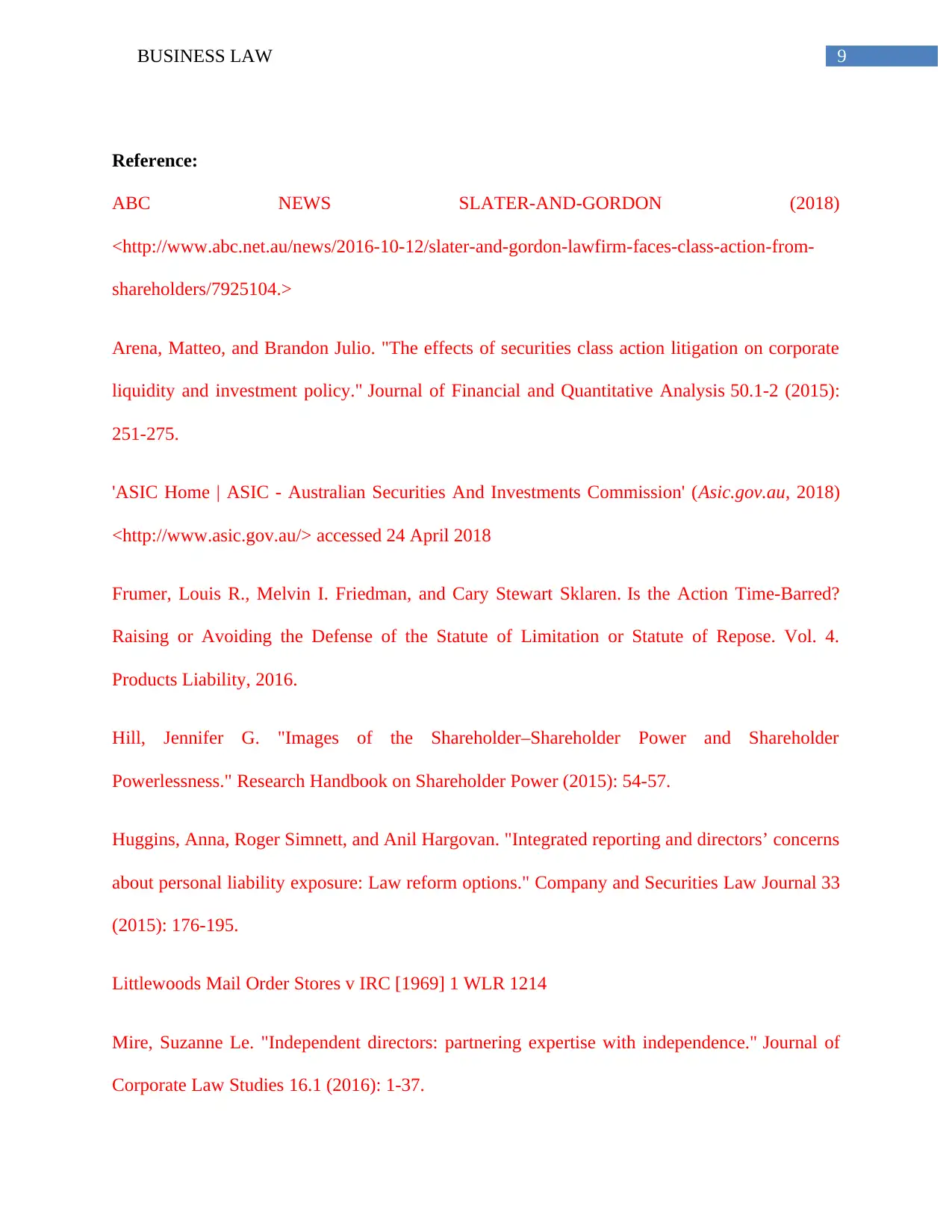
9BUSINESS LAW
Reference:
ABC NEWS SLATER-AND-GORDON (2018)
<http://www.abc.net.au/news/2016-10-12/slater-and-gordon-lawfirm-faces-class-action-from-
shareholders/7925104.>
Arena, Matteo, and Brandon Julio. "The effects of securities class action litigation on corporate
liquidity and investment policy." Journal of Financial and Quantitative Analysis 50.1-2 (2015):
251-275.
'ASIC Home | ASIC - Australian Securities And Investments Commission' (Asic.gov.au, 2018)
<http://www.asic.gov.au/> accessed 24 April 2018
Frumer, Louis R., Melvin I. Friedman, and Cary Stewart Sklaren. Is the Action Time-Barred?
Raising or Avoiding the Defense of the Statute of Limitation or Statute of Repose. Vol. 4.
Products Liability, 2016.
Hill, Jennifer G. "Images of the Shareholder–Shareholder Power and Shareholder
Powerlessness." Research Handbook on Shareholder Power (2015): 54-57.
Huggins, Anna, Roger Simnett, and Anil Hargovan. "Integrated reporting and directors’ concerns
about personal liability exposure: Law reform options." Company and Securities Law Journal 33
(2015): 176-195.
Littlewoods Mail Order Stores v IRC [1969] 1 WLR 1214
Mire, Suzanne Le. "Independent directors: partnering expertise with independence." Journal of
Corporate Law Studies 16.1 (2016): 1-37.
Reference:
ABC NEWS SLATER-AND-GORDON (2018)
<http://www.abc.net.au/news/2016-10-12/slater-and-gordon-lawfirm-faces-class-action-from-
shareholders/7925104.>
Arena, Matteo, and Brandon Julio. "The effects of securities class action litigation on corporate
liquidity and investment policy." Journal of Financial and Quantitative Analysis 50.1-2 (2015):
251-275.
'ASIC Home | ASIC - Australian Securities And Investments Commission' (Asic.gov.au, 2018)
<http://www.asic.gov.au/> accessed 24 April 2018
Frumer, Louis R., Melvin I. Friedman, and Cary Stewart Sklaren. Is the Action Time-Barred?
Raising or Avoiding the Defense of the Statute of Limitation or Statute of Repose. Vol. 4.
Products Liability, 2016.
Hill, Jennifer G. "Images of the Shareholder–Shareholder Power and Shareholder
Powerlessness." Research Handbook on Shareholder Power (2015): 54-57.
Huggins, Anna, Roger Simnett, and Anil Hargovan. "Integrated reporting and directors’ concerns
about personal liability exposure: Law reform options." Company and Securities Law Journal 33
(2015): 176-195.
Littlewoods Mail Order Stores v IRC [1969] 1 WLR 1214
Mire, Suzanne Le. "Independent directors: partnering expertise with independence." Journal of
Corporate Law Studies 16.1 (2016): 1-37.
Paraphrase This Document
Need a fresh take? Get an instant paraphrase of this document with our AI Paraphraser
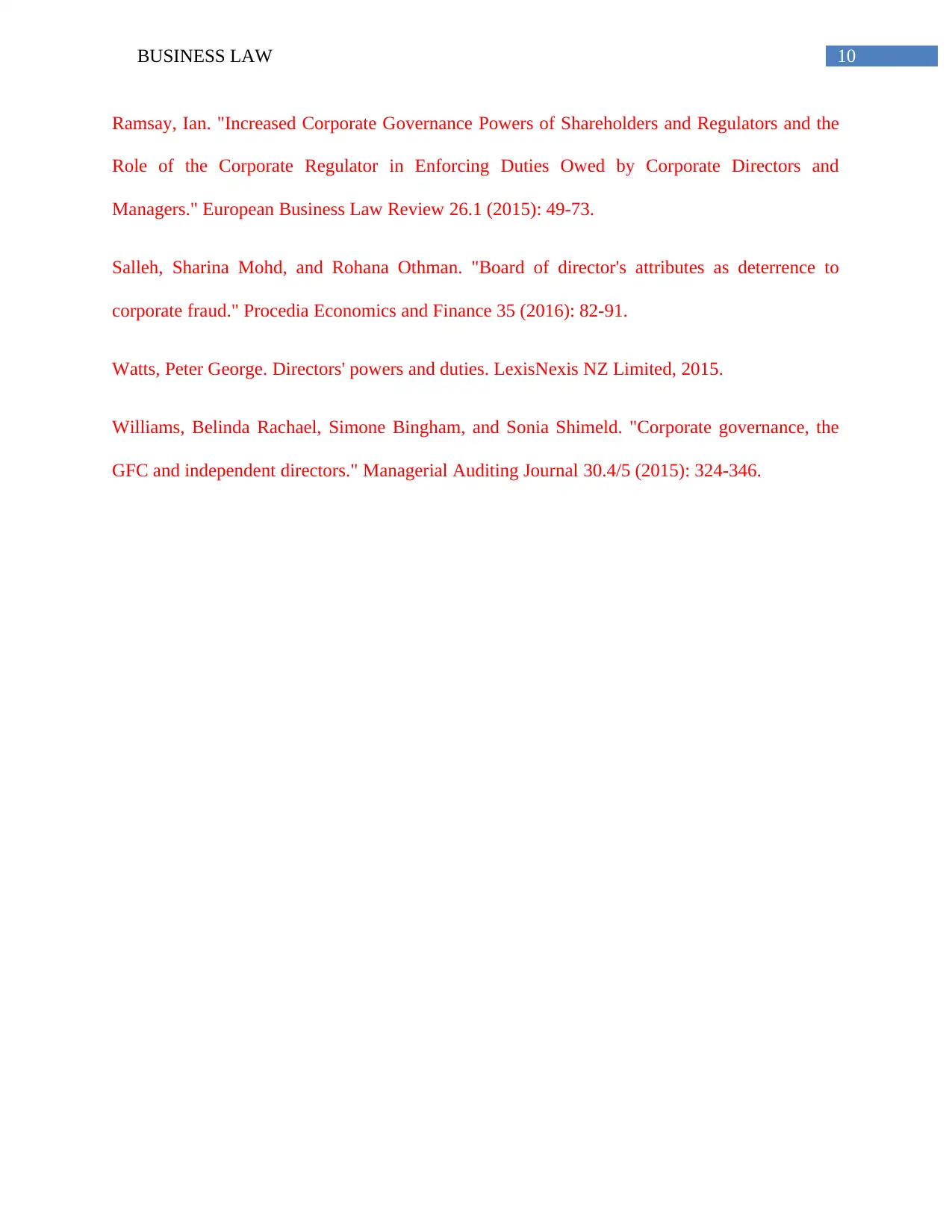
10BUSINESS LAW
Ramsay, Ian. "Increased Corporate Governance Powers of Shareholders and Regulators and the
Role of the Corporate Regulator in Enforcing Duties Owed by Corporate Directors and
Managers." European Business Law Review 26.1 (2015): 49-73.
Salleh, Sharina Mohd, and Rohana Othman. "Board of director's attributes as deterrence to
corporate fraud." Procedia Economics and Finance 35 (2016): 82-91.
Watts, Peter George. Directors' powers and duties. LexisNexis NZ Limited, 2015.
Williams, Belinda Rachael, Simone Bingham, and Sonia Shimeld. "Corporate governance, the
GFC and independent directors." Managerial Auditing Journal 30.4/5 (2015): 324-346.
Ramsay, Ian. "Increased Corporate Governance Powers of Shareholders and Regulators and the
Role of the Corporate Regulator in Enforcing Duties Owed by Corporate Directors and
Managers." European Business Law Review 26.1 (2015): 49-73.
Salleh, Sharina Mohd, and Rohana Othman. "Board of director's attributes as deterrence to
corporate fraud." Procedia Economics and Finance 35 (2016): 82-91.
Watts, Peter George. Directors' powers and duties. LexisNexis NZ Limited, 2015.
Williams, Belinda Rachael, Simone Bingham, and Sonia Shimeld. "Corporate governance, the
GFC and independent directors." Managerial Auditing Journal 30.4/5 (2015): 324-346.
1 out of 11
Related Documents
Your All-in-One AI-Powered Toolkit for Academic Success.
+13062052269
info@desklib.com
Available 24*7 on WhatsApp / Email
![[object Object]](/_next/static/media/star-bottom.7253800d.svg)
Unlock your academic potential
Copyright © 2020–2025 A2Z Services. All Rights Reserved. Developed and managed by ZUCOL.




